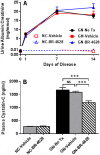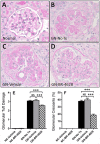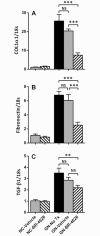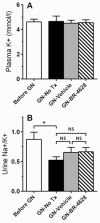Suppression of Rapidly Progressive Mouse Glomerulonephritis with the Non-Steroidal Mineralocorticoid Receptor Antagonist BR-4628 - PubMed (original) (raw)
Suppression of Rapidly Progressive Mouse Glomerulonephritis with the Non-Steroidal Mineralocorticoid Receptor Antagonist BR-4628
Frank Y Ma et al. PLoS One. 2015.
Abstract
Background/aim: Steroidal mineralocorticoid receptor antagonists (MRAs) are effective in the treatment of kidney disease; however, the side effect of hyperkalaemia, particularly in the context of renal impairment, is a major limitation to their clinical use. Recently developed non-steroidal MRAs have distinct characteristics suggesting that they may be superior to steroidal MRAs. Therefore, we explored the benefits of a non-steroidal MRA in a model of rapidly progressive glomerulonephritis.
Methods: Accelerated anti-glomerular basement membrane (GBM) glomerulonephritis was induced in groups of C57BL/6J mice which received no treatment, vehicle or a non-steroidal MRA (BR-4628, 5mg/kg/bid) from day 0 until being killed on day 15 of disease. Mice were examined for renal injury.
Results: Mice with anti-GBM glomerulonephritis which received no treatment or vehicle developed similar disease with severe albuminuria, impaired renal function, glomerular tuft damage and crescents in 40% of glomeruli. In comparison, mice which received BR-4628 displayed similar albuminuria, but had improved renal function, reduced severity of glomerular tuft lesions and a 50% reduction in crescents. The protection seen in BR-4628 treated mice was associated with a marked reduction in glomerular macrophages and T-cells and reduced kidney gene expression of proinflammatory (CCL2, TNF-α, IFN-γ) and profibrotic molecules (collagen I, fibronectin). In addition, treatment with BR-4626 did not cause hyperkalaemia or increase urine Na+/K+ excretion (a marker of tubular dysfunction).
Conclusions: The non-steroidal MRA (BR-4628) provided substantial suppression of mouse crescentic glomerulonephritis without causing tubular dysfunction. This finding warrants further investigation of non-steroidal MRAs as a therapy for inflammatory kidney diseases.
Conflict of interest statement
Competing Interests: The authors have read the journal's policy and have the following competing interests: PK is an employee of Bayer Healthcare and is involved in Bayer's development of non-steroidal mineralocorticoid receptor antagonists for clinical use. This did not alter the authors' adherence to PLOS ONE policies on sharing data and materials.
Figures
Fig 1. BR-4628 protects mice from loss of renal function in anti-GBM glomerulonephritis.
(A) Compared to normal control (NC) mice given vehicle (red unfilled squares) or BR-4628 (blue unfilled triangles), urine albumin excretion was massively increased at days 1, 7 and 14 of glomerulonephritis (GN) in mice receiving no treatment (No Tx, black filled circles) or vehicle (red filled squares), and these albuminuria levels were unaffected by treatment with BR-4628 (blue filled triangles). (B) At day 15 of glomerulonephritis, there was a 6-fold increase in serum levels of cystatin-C in mice receiving no treatment or vehicle, which was reduced by 30% in mice treated with BR-4628. Data = mean ± SEM; n = 8. ***p<0.001.
Fig 2. BR-4628 reduces glomerular lesions in anti-GBM glomerulonephritis.
Histological staining with PAS and hematoxylin shows the kidney structure of (A) a normal mouse. In comparison, there is severe damage to glomeruli (capillary thrombosis, glomerulosclerosis, crescent formation) at day 15 of glomerulonephritis in (B) a mouse receiving no treatment and (C) a mouse receiving vehicle, which is attenuated in (D) a mouse treated with BR-4628. Graphs show (E) the severity score of glomerular tuft damage (0–4+) and (F) the percentage of glomeruli with crescents in kidneys from normal control (NC) mice and mice with glomerulonephritis (GN) receiving no treatment (No Tx), vehicle or BR-4628. Magnification: (A-D) x400. Graph Data = mean ± SEM; n = 8. *p<0.05, ***p<0.001, NS = not significant.
Fig 3. BR-4628 reduces tubular damage in anti-GBM glomerulonephritis.
Histological staining with PAS and hematoxylin shows the structure of kidney tubules in (A) a normal mouse. In comparison, there is severe damage to tubules (dilation, atrophy, cell loss) at day 15 of glomerulonephritis in (B) a mouse receiving no treatment and (C) a mouse receiving vehicle, which is attenuated in (D) a mouse treated with BR-4628. Graphs show (E) the number of activated caspase-3+ apoptotic cells in tubules in the kidney cortex and (F) the gene expression of kidney injury molecule-1 (KIM-1) in kidneys from normal control (NC) mice and mice with glomerulonephritis (GN) receiving no treatment (No Tx), vehicle or BR-4628. Magnification: (A-D) x400. Graph Data = mean ± SEM; n = 8. *p<0.05, ***p<0.001, NS = not significant.
Fig 4. BR-4628 reduces kidney gene expression of pro-fibrotic molecules in anti-GBM glomerulonephritis.
RT-PCR analysis showed that in comparison to normal control (NC) mice, there was a marked increase in the kidney mRNA levels of (A) collagen 1 (α1 chain), (B) fibronectin and (C) TGF-β1 at day 15 of glomerulonephritis in mice receiving no treatment (No Tx), which was similar to mice receiving vehicle. Treatment with BR-4628 reduced the kidney mRNA level of each of these profibrotic molecules. Data = mean ± SEM; n = 8. **p<0.01, ***p<0.001, NS = not significant.
Fig 5. BR-4628 reduces inflammation in anti-GBM glomerulonephritis.
Immunostaining of a CD68+ macrophage (brown) was seen in a minor proportion of (A) the glomeruli of normal control (NC) mice. In comparison, there was substantial accumulation of CD68+ macrophages in mice with glomerulonephritis receiving (B) no treatment or (C) vehicle, which was reduced in (D) mice receiving BR-4628. Quantification of immunostaining of (E) glomerular CD68+ macrophages and (F) glomerular CD3+ T-cells show that there was a marked increase in the glomerular numbers of these cells in mice with glomerulonephritis receiving no treatment (No Tx) or vehicle, which was attenuated in mice receiving BR-4628. Furthermore, RT-PCR analysis showed that the development of glomerulonephritis resulted in significant increases in the kidney gene expression of (G) CD68, (H) CD3e, (I) CCL2, (J) TNF-α, (K) IFN-γ and (L) MMP-12 at day 15, which was reduced in mice receiving BR-4628. Magnification (A-D) x400. Graphed Data = mean ± SEM; n = 8. *p<0.05, **p<0.01, ***p<0.001.
Fig 6. BR-4628 does not alter salt balance.
(A) Plasma levels of K+ were similar in mice with and without glomerulonephritis, and were not affected by BR-4628 treatment. (B) After the development of glomerulonephritis there was slight reduction in urine levels of Na+/K+ in mice which received no treatment (No Tx), which was not altered by treatment with vehicle or BR-4628. Data = mean ± SEM; n = 8. *p<0.05, NS = not significant.
Similar articles
- Matrix metalloproteinase-12 deficiency attenuates experimental crescentic anti-glomerular basement membrane glomerulonephritis.
Abraham AP, Ma FY, Mulley WR, Nikolic-Paterson DJ, Tesch GH. Abraham AP, et al. Nephrology (Carlton). 2018 Feb;23(2):183-189. doi: 10.1111/nep.12964. Nephrology (Carlton). 2018. PMID: 27862656 - c-fms blockade reverses glomerular macrophage infiltration and halts development of crescentic anti-GBM glomerulonephritis in the rat.
Han Y, Ma FY, Tesch GH, Manthey CL, Nikolic-Paterson DJ. Han Y, et al. Lab Invest. 2011 Jul;91(7):978-91. doi: 10.1038/labinvest.2011.61. Epub 2011 Apr 25. Lab Invest. 2011. PMID: 21519331 - Immune modulation with interleukin-4 and interleukin-10 prevents crescent formation and glomerular injury in experimental glomerulonephritis.
Tipping PG, Kitching AR, Huang XR, Mutch DA, Holdsworth SR. Tipping PG, et al. Eur J Immunol. 1997 Feb;27(2):530-7. doi: 10.1002/eji.1830270226. Eur J Immunol. 1997. PMID: 9045927 - Differentiation between emerging non-steroidal and established steroidal mineralocorticoid receptor antagonists: head-to-head comparisons of pharmacological and clinical characteristics.
Barrera-Chimal J, Kolkhof P, Lima-Posada I, Joachim A, Rossignol P, Jaisser F. Barrera-Chimal J, et al. Expert Opin Investig Drugs. 2021 Nov;30(11):1141-1157. doi: 10.1080/13543784.2021.2002844. Epub 2021 Dec 6. Expert Opin Investig Drugs. 2021. PMID: 34758679 Review. - Potential Impact of Non-Steroidal Mineralocorticoid Receptor Antagonists in Cardiovascular Disease.
Rahman A, Jahan N, Rahman MT, Nishiyama A. Rahman A, et al. Int J Mol Sci. 2023 Jan 18;24(3):1922. doi: 10.3390/ijms24031922. Int J Mol Sci. 2023. PMID: 36768246 Free PMC article. Review.
Cited by
- The Nonsteroidal Mineralocorticoid-Receptor-Antagonist Finerenone in Cardiorenal Medicine: A State-of-the-Art Review of the Literature.
Georgianos PI, Agarwal R. Georgianos PI, et al. Am J Hypertens. 2023 Feb 24;36(3):135-143. doi: 10.1093/ajh/hpac124. Am J Hypertens. 2023. PMID: 36331811 Free PMC article. Review. - Mineralocorticoid Receptor Antagonism in Chronic Kidney Disease.
Georgianos PI, Agarwal R. Georgianos PI, et al. Kidney Int Rep. 2021 Jun 10;6(9):2281-2291. doi: 10.1016/j.ekir.2021.05.027. eCollection 2021 Sep. Kidney Int Rep. 2021. PMID: 34514191 Free PMC article. Review. - Investigating new treatment opportunities for patients with chronic kidney disease in type 2 diabetes: the role of finerenone.
Agarwal R, Anker SD, Bakris G, Filippatos G, Pitt B, Rossing P, Ruilope L, Gebel M, Kolkhof P, Nowack C, Joseph A; FIDELIO-DKD and FIGARO-DKD Investigators. Agarwal R, et al. Nephrol Dial Transplant. 2022 May 25;37(6):1014-1023. doi: 10.1093/ndt/gfaa294. Nephrol Dial Transplant. 2022. PMID: 33280027 Free PMC article.
References
Publication types
MeSH terms
Substances
Grants and funding
GHT received funding from Bayer Healthcare to perform the study. PK is an employee of Bayer Healthcare and played a role in study design and manuscript preparation.
LinkOut - more resources
Full Text Sources
Other Literature Sources





